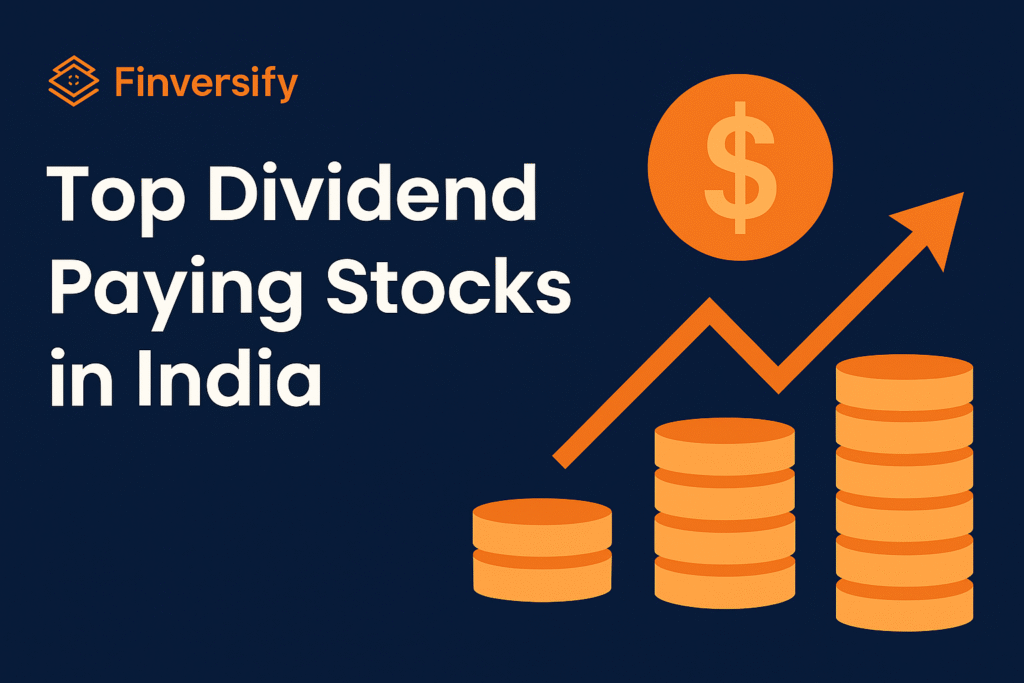
Introduction
In a market that often rewards capital gains, many investors overlook a powerful source of returns: dividends. A dividend is a portion of a company’s profit paid to shareholders, and for many investors, it acts like passive income. If you are aiming for consistent income while holding quality stocks, dividend-paying companies become key candidates.
This blog dives deep into the top dividend paying stocks in India (2025), how to pick them, and how you can build a balanced dividend-focused portfolio. Whether you are a long-term investor or seeking “coffee-money” from your holdings, this guide is for you.
Why Dividend Stocks Matter
- Regular Income: Unlike capital gains, dividends can provide cash flow even when markets are flat.
- Lower Volatility Cushion: Dividend payers often belong to mature, stable companies less prone to sharp swings.
- Compounding Power: Reinvested dividends can significantly boost long-term returns.
- Inflation Hedge: Over time, growing dividends can help offset inflation.
- Total Return Component: In many years, dividends make up 30–50% of total returns in equity markets.
However, not all dividend stocks are equal. A high dividend yield may look tempting but can be risky if not supported by strong fundamentals. Let’s look at how to evaluate them before jumping into the picks.
How to Evaluate Dividend Paying Stocks
Before selecting the top dividend stocks, here are critical metrics and qualitative checks:
| Metric / Check | What to Look For | Ideal Range / Condition |
|---|---|---|
| Dividend Yield | Dividend per share / current price | Typically 3%–8% for large caps; very high yields (10%+) need deeper scrutiny |
| Payout Ratio | (%) of earnings paid as dividend | Preferably < 60–70% (too high suggests unsustainability) |
| Earnings Growth | Ability to grow profits over time | 5–15%+ annual growth is favorable |
| Cash Flow Quality | Strong operating cash flows | Free cash flow should comfortably cover dividends |
| Debt Levels | Lower leverage is safer | Debt/Equity ratio < 1 (or manageable for sector norms) |
| Consistency & Track Record | Stable dividend history | Companies with 5–10+ years of dividend stability or growth |
| Sector & Business Model | Defensive or regulated sectors often fare better | Utilities, power, oil & gas, infrastructure, telecom etc. |
Top Dividend Paying Stocks in India (2025 Picks)
Here’s a curated set of high-dividend stocks in India, combining yield, stability, reputation, and future prospects.
| Company | Approx Dividend Yield* | Why It Stands Out | Risks to Consider |
|---|---|---|---|
| Coal India Ltd. | ~6–8%+ | Large PSU, cash rich, consistent dividend history ET Money+1 | Commodity risk, regulatory & environmental pressures |
| Vedanta Ltd. | ~8–10% | Diversified mining & metals business, potential for cyclical upside Tickertape+2smallcase+2 | Volatility in commodity cycles, capital expenditure needs |
| Hindustan Zinc Ltd. | ~5–7% | Part of Vedanta, strong balance sheet, lower volatility | Metal prices, input costs, regulatory risk |
| Castrol India Ltd. | ~5–6% | Niche in lubricants, steady demand, moderate payout | Commodity risk, margin pressure from raw oils |
| PTC India Ltd. | ~6–7% | In the power sector, steady cash flows | Regulatory risk, currency & interest rates |
| MSTC Ltd. | ~7–8% | Government-linked, consistent dividend yield record ET Money+1 | Limited growth potential, niche business dependencies |
| Gujarat Pipavav Port Ltd. | ~5% | Infrastructure play, steady usage | Port traffic risk, regulatory & environmental hurdles |
| Canara Bank | High yield | Some public sources show very high yields in banking ET Money | Banking sector stress, NPAs, regulatory policy risk |
*Yields may fluctuate. Always cross-check latest data before investing.
Let’s explore a few of these in more detail.
Coal India Ltd.
Why It’s Attractive: As one of India’s major coal producers with significant government backing, Coal India has shown solid ability to generate profits and distribute them. In recent times, it has offered yields that beat comparable fixed-income rates.
Caution: Coal is sensitive to commodity cycles, regulatory changes, carbon pricing, and environmental pressures.
Vedanta Ltd.
Strengths: Vedanta’s diversified portfolio across mining, metals, oil & gas and its ability to generate cash enables dividend potential. It’s among names listed in high dividend stock lists by multiple platforms.
Risks: Its profitability is linked to commodity cycles, and capex demands are high in mining sectors. Also, large investments and debt management must be watched closely.
Hindustan Zinc Ltd.
Operating under Vedanta, Hindustan Zinc has a relatively stable business, with lower volatility compared to mining for some metals. Its dividend payout has historically been reliable.
Risks: Dependent on zinc, lead, silver prices, regulatory oversight, energy costs, and global demand trends.
Castrol India Ltd.
For those wanting exposure outside pure metals or mining, Castrol India offers exposure to lubricants. It tends to have steadier margins during cycles due to branding and distribution.
Risks: Sensitivity to crude oil and base oil prices, competition from global players, margin pressure from raw cost swings.
How to Build a Dividend Portfolio
- Diversify Across Sectors
Don’t rely only on mining or power. Mix sectors like utilities, infrastructure, consumer, energy to reduce sector risk. - Balance Yield & Growth
Some stocks give high yield now but limited growth. Others give lower yield but high growth. A mix works best. - Stagger Entry
Instead of investing lump sum, consider SIP / staggered buys over a few weeks to average entry price. - Reinvest Dividends
If your portfolio allows, reinvesting dividends can compound growth over time. - Monitor Payout Ratios & Financial Health
A sudden drop or cut in dividend often comes from deteriorating fundamentals. - Tax Efficiency
Understand dividend taxation. In India, dividends are taxed in the hands of the investor now (after the abolition of DDT). Wikipedia - Stay Updated on Announcements
Keep track of Record Dates, Ex-Dividend Dates, Board Meetings, and any govt or policy changes that could affect high dividend stocks.
Risks & Caveats in Dividend Investing
- High Yield Traps: Exceptionally high yields (>10–15%) can indicate distress.
- Cut Risk: Companies can reduce/suspend dividends in downturns.
- Inflation & Interest Rate: High inflation or rising interest rates can erode dividend attractiveness.
- Sector-specific Risks: Regulatory changes, commodity cycles, environmental constraints can impact payers.
- Currency & Macro Risks: For commodity-linked stocks, global demand and currency swings matter.
Case Study: HCL Tech — Dividend Consistency
HCL Technologies recently announced its 91st consecutive quarterly dividend at ₹12 per share, emphasizing its focus on returning capital to shareholders. The Economic Times
It’s not a high-yield stock, but the consistency showcases the kind of stable dividend philosophy ideal for portfolio builders.
Actionable Steps for Investors
- Shortlist 5–7 dividend stocks using the metrics above.
- Check ex-dividend & record dates to catch upcoming payouts.
- Monitor quarterly earnings and free cash flows.
- Rebalance annually if dividend yield or fundamentals shift.
- Use a dividend tracker spreadsheet to track yields, payouts, growth.
Conclusion
“Top dividend paying stocks in India” is not just a phrase — it’s a strategy for those seeking income plus capital gains. While the likes of Coal India, Vedanta, Hindustan Zinc, and Castrol India often feature in dividend lists, what distinguishes a great dividend stock is sustainability, growth, and strong fundamentals.
